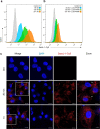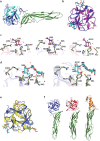The choanoflagellate pore-forming lectin SaroL-1 punches holes in cancer cells by targeting the tumor-related glycosphingolipid Gb3
- PMID: 36097056
- PMCID: PMC9468336
- DOI: 10.1038/s42003-022-03869-w
The choanoflagellate pore-forming lectin SaroL-1 punches holes in cancer cells by targeting the tumor-related glycosphingolipid Gb3
Abstract
Choanoflagellates are primitive protozoa used as models for animal evolution. They express a large variety of multi-domain proteins contributing to adhesion and cell communication, thereby providing a rich repertoire of molecules for biotechnology. Adhesion often involves proteins adopting a β-trefoil fold with carbohydrate-binding properties therefore classified as lectins. Sequence database screening with a dedicated method resulted in TrefLec, a database of 44714 β-trefoil candidate lectins across 4497 species. TrefLec was searched for original domain combinations, which led to single out SaroL-1 in the choanoflagellate Salpingoeca rosetta, that contains both β-trefoil and aerolysin-like pore-forming domains. Recombinant SaroL-1 is shown to bind galactose and derivatives, with a stronger affinity for cancer-related α-galactosylated epitopes such as the glycosphingolipid Gb3, when embedded in giant unilamellar vesicles or cell membranes. Crystal structures of complexes with Gb3 trisaccharide and GalNAc provided the basis for building a model of the oligomeric pore. Finally, recognition of the αGal epitope on glycolipids required for hemolysis of rabbit erythrocytes suggests that toxicity on cancer cells is achieved through carbohydrate-dependent pore-formation.
© 2022. The Author(s).
Conflict of interest statement
The authors declare no competing interests.
Figures








Similar articles
-
Structural basis of the preferential binding for globo-series glycosphingolipids displayed by Pseudomonas aeruginosa lectin I.J Mol Biol. 2008 Nov 21;383(4):837-53. doi: 10.1016/j.jmb.2008.08.028. Epub 2008 Aug 22. J Mol Biol. 2008. PMID: 18762193
-
C-type lectin-like carbohydrate recognition of the hemolytic lectin CEL-III containing ricin-type -trefoil folds.J Biol Chem. 2007 Dec 28;282(52):37826-35. doi: 10.1074/jbc.M705604200. Epub 2007 Oct 31. J Biol Chem. 2007. PMID: 17977832
-
Structural Diversities of Lectins Binding to the Glycosphingolipid Gb3.Front Mol Biosci. 2021 Jul 26;8:704685. doi: 10.3389/fmolb.2021.704685. eCollection 2021. Front Mol Biosci. 2021. PMID: 34381814 Free PMC article. Review.
-
Structural analysis of the Laetiporus sulphureus hemolytic pore-forming lectin in complex with sugars.J Biol Chem. 2005 Apr 29;280(17):17251-9. doi: 10.1074/jbc.M413933200. Epub 2005 Feb 1. J Biol Chem. 2005. PMID: 15687495
-
Choanoflagellate models - Monosiga brevicollis and Salpingoeca rosetta.Curr Opin Genet Dev. 2016 Aug;39:42-47. doi: 10.1016/j.gde.2016.05.016. Epub 2016 Jun 17. Curr Opin Genet Dev. 2016. PMID: 27318693 Review.
Cited by
-
BiotechLec: an interactive guide of commercial lectins for glycobiology and biomedical research applications.Glycobiology. 2023 Oct 29;33(9):684-686. doi: 10.1093/glycob/cwad034. Glycobiology. 2023. PMID: 37083961 Free PMC article.
-
HumanLectome, an update of UniLectin for the annotation and prediction of human lectins.Nucleic Acids Res. 2024 Jan 5;52(D1):D1683-D1693. doi: 10.1093/nar/gkad905. Nucleic Acids Res. 2024. PMID: 37889052 Free PMC article.
-
Taxonomic Distribution and Molecular Evolution of Mytilectins.Mar Drugs. 2023 Nov 27;21(12):614. doi: 10.3390/md21120614. Mar Drugs. 2023. PMID: 38132935 Free PMC article. Review.
-
Elucidating the glycan-binding specificity and structure of Cucumis melo agglutinin, a new R-type lectin.Beilstein J Org Chem. 2024 Feb 19;20:306-320. doi: 10.3762/bjoc.20.31. eCollection 2024. Beilstein J Org Chem. 2024. PMID: 38410776 Free PMC article.
-
Tandem-repeat lectins: structural and functional insights.Glycobiology. 2024 May 26;34(7):cwae041. doi: 10.1093/glycob/cwae041. Glycobiology. 2024. PMID: 38857376 Free PMC article.
References
Publication types
MeSH terms
Substances
LinkOut - more resources
Full Text Sources
Medical

